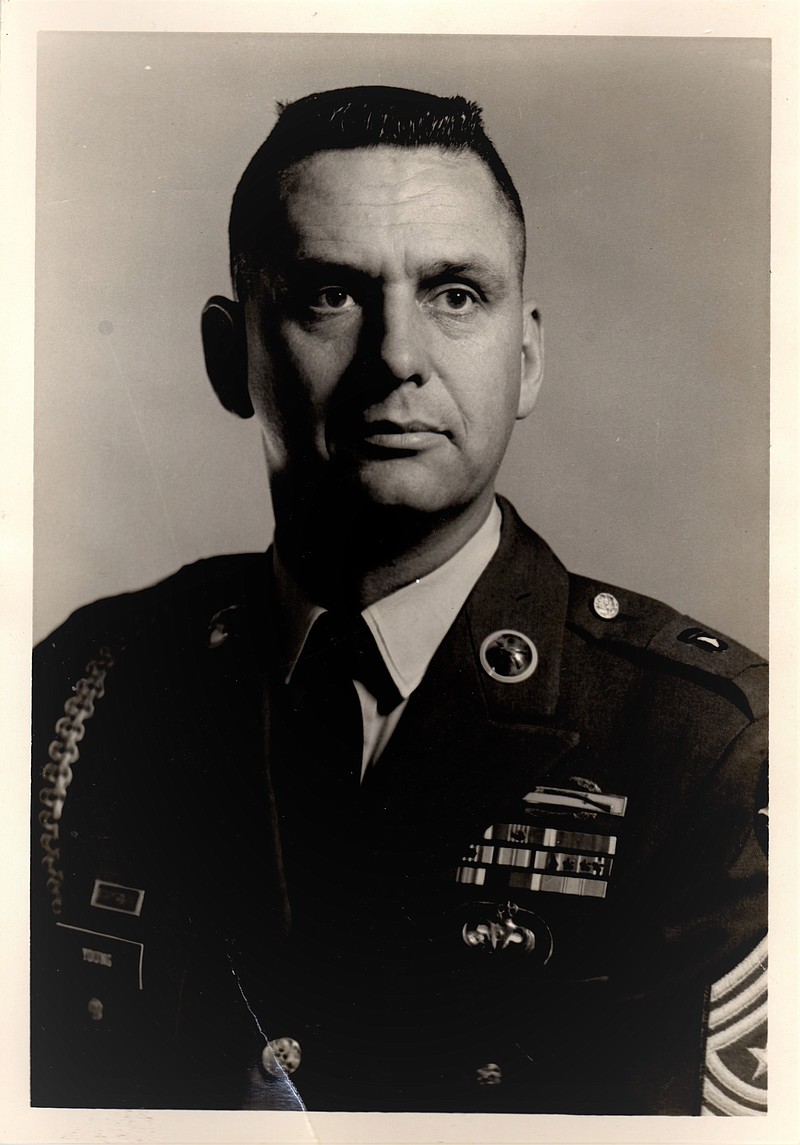Sitting upon a dusty shelf in a shadowy nook of an antique store in Jefferson City was an ornate copper mug etched with Vietnam War service dates, which held a small U.S. flag and a time-curled military photograph of a soldier from Missouri - all for the meager price of $5. This inexpensive purchase of a war memento revealed details about a soldier from Missouri, who, during his 30-year-career, served as a paratrooper making more than 100 parachute jumps and achieving the highest of enlisted ranks - command sergeant major.
Graduating from high school in the north-central Missouri community of Green City in 1942, Robert A. Young's draft registration card dated June 29, 1942, notes the 18-year-old was living in Chicago, where he was employed by the Cleveland Container Company.
However, on April 8, 1943, he conceded to a higher calling when leaving his manufacturing job and enlisting in the U.S. Army. After entering the service at Ft. Leavenworth, Kansas, he was soon assigned to the 17th Airborne Division - one of five airborne divisions formed in World War II.
In his book "World War II Order of Battle," Shelby L. Stanton explains the 17th Airborne was "activated at (Camp) Mackall, N.C. and participated in the Carolina Airborne-Troop Carrier Command Maneuvers (from Dec. 6-10, 1943)." He further noted the division then "moved to the Tennessee Maneuvers Area and took part in the Second Army No. 5 Maneuvers."
Young was just a 20-year-old paratrooper when he arrived in England with the division in late August 1944. Four months later, he received his baptism of fire during the Battle of the Bulge when "the inexperienced 17th Airborne Division was rushed to the front from England and took part in the Allied counteroffensive," Matthew J. Seelinger noted in an article for the National Museum of the United States Army.
Following the Battle of the Bulge, the division was engaged in clearing operations and, in late March 1945, participated in airborne assaults near the Rhine River north of the German town of Wesel. Throughout the next several weeks, they led attacks, cleared towns of pockets of German resistance and relieved other divisions.
When the war came to an end May 7, 1945, the 17th Airborne Division received credit for three campaigns of the war after suffering 1,191 of its soldiers killed in action. The division returned to the United States in September 1945; however, Young was reassigned to the 82nd Airborne Division and remained in Germany with the occupational forces.
He eventually decided to make a career of the U.S. Army, climbing through the enlisted ranks and moving "to Ft. Campbell, Kentucky, then to Japan to work on 'Operation Gyroscope' before returning to Ft. Campbell to form the 101st ABN (Airborne) Division," his obituary noted.
The Leaf-Chronicle, a newspaper printed in Clarksville, Tennessee, reported on Jan. 20, 1958, that Master Sgt. Young was among a group of nine battle-hardened soldiers of the 506th Airborne Infantry of the 101st Airborne Division awarded "gold wings" when becoming members of the "century club," by individually making more than 100 airborne parachute jumps. The paper noted Young, who was fulfilling the role of sergeant major for the 506th, was credited with 126 jumps.
Young was called the "Currahee group sergeant major" - a reference dating back to World War II. "Currahee" became the motto of the 506th Infantry Regiment during the war because of Currahee Mountain at Camp Toccoa, Georgia - a former paratrooper training camp. Running up and down the mountain during training helped build camaraderie amongst the airborne troopers.
Several weeks later, on March 20, 1958, the Leaf-Chronicle printed Young "thought up the idea" of formalizing the qualification process for Master and Senior parachutists by "issuing qualification cards" signed by the group commander. As the paper explained, the billfold-size cards were to help "develop a closer brotherhood amongst its older jumpers."
The following year, in 1959, Young was promoted to the rank of command sergeant major and, in 1962, married the former Betty Jane Judge. He went on to serve a tour in Korea followed by a stint with the U.S. Strike Command in Florida, before returning to the 101st Airborne Division.
During the Vietnam War, Command Sgt. Maj. Young led troops of the 101st Airborne Division during two tours. He was revered by those under his command and presented a copper mug by the soldiers of First Brigade that was emblazoned with the emblem of the division.
According to the Sept. 2, 1969, edition of the Austin-American Statesman, Sgt. Maj. Young assumed the top enlisted post at a major military base when he was appointed to replace retiring Sgt. Maj. Willard V. Hunter as the "command sergeant major of III Corps and Fort Hood (Texas)." His career came to a close in 1973, when he finished his 30-year career at the Presidio of San Francisco.
He eventually settled in his hometown of Green City, enjoying many years of retirement while seeking escape from the haunting recollections of those lost in his career and personal life, including his wife, who passed away in 1981. Following his death in 2016, having no children to carry forth his legacy, Young's engraved mug from Vietnam, along with other unknown treasures, was sold off and awaited rediscovery.
Although former Vice President Adali Stephenson never met Command Sgt. Maj. Young, his intuitive observation regarding the devotion of those pursuing military careers aptly describes the selfless service of the late paratrooper, characterized in fascinating story unexpectedly uncovered through an antique store find.
"Patriotism is not short, frenzied outbursts of emotion, but the tranquil and steady dedication of a lifetime."
Jeremy P. Amick writes on behalf of the Silver Star Families of America.

